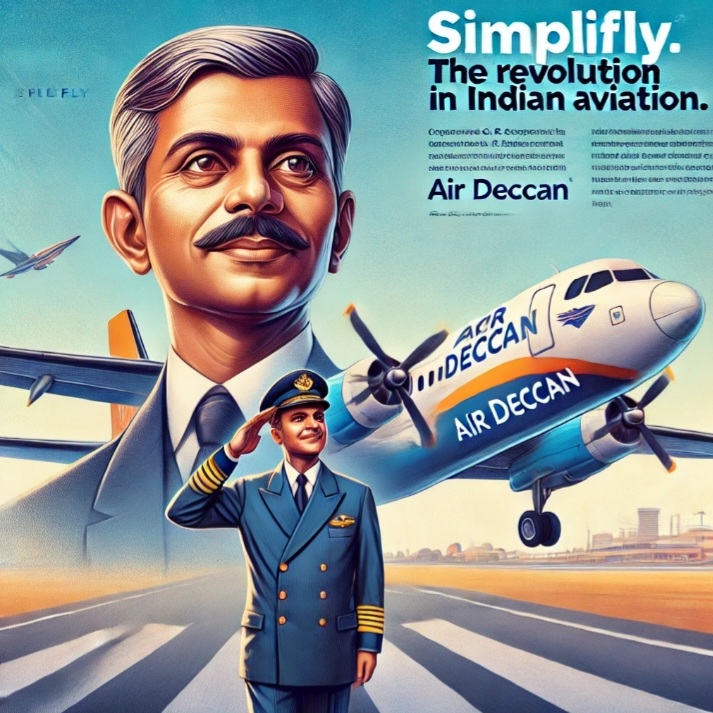The Journey of Air Deccan: India’s First Low-Cost Airline
Air Deccan AeroplanePosted by admin on 2025-02-18 04:30:23 | Last Updated by admin on 2025-08-29 04:30:24
Share: Facebook | Twitter | Whatsapp | Linkedin Visits: 210

Captain G.R. Gopinath and Air Deccan: A Revolution in Indian Aviation
Captain G.R. Gopinath is a name that revolutionized Indian aviation. He is a former army officer and a visionary entrepreneur who transformed the dream of affordable air travel into reality for millions of Indians. In 2003, he founded Air Deccan, India’s first low-cost airline, which made air travel accessible to the common man.
Early Life and Career
- Born on November 13, 1951, in Melkote village, Hassan district, Karnataka.
- Grew up in a humble family with a strong focus on education and discipline.
- Served in the Indian Army for eight years and fought during the 1971 Indo-Pak war.
- After leaving the army, ventured into various fields like agriculture, sericulture, motorbike dealership, and helicopter services.
The Birth of Air Deccan
- In 2003, Captain Gopinath launched Air Deccan with the mission to democratize air travel.
- The airline’s tagline, **"Simplifly"**, reflected its goal to simplify flying and make it affordable.
- Air Deccan introduced a revolutionary fare system, offering tickets as low as **₹1**, making headlines across the nation.
- The airline primarily targeted tier-2 and tier-3 cities, connecting remote areas with major metros.
Key Features and Innovations
- Low-Cost Model:- Air Deccan adopted a no-frills model, eliminating luxuries to reduce costs.
- Online Booking:- Introduced online ticket booking, making it easier and more transparent for customers.
- Point-to-Point Routes:- Focused on direct flights instead of traditional hub-and-spoke models.
- Open Seating: Implemented free seating, encouraging passengers to board early for better seats.
- Multi-Aircraft Fleet:- Used both ATR turboprops for short routes and Airbus A320s for longer distances.
Impact on Indian Aviation
- Affordable Air Travel:- Brought down airfares drastically, enabling middle-class families to fly for the first time.
- Regional Connectivity:- Connected smaller towns and cities, bridging the urban-rural divide.
- Market Competition:- Forced established airlines to reduce fares and improve services.
- Passenger Growth: Contributed to the exponential rise in domestic air passengers in India.
Challenges and Setbacks
- Financial Struggles:- Rapid expansion led to financial instability and operational difficulties.
- Operational Issues: Frequent delays and maintenance problems affected customer satisfaction.
- Competition:- Entry of other low-cost carriers intensified the price war.
- Merger with Kingfisher:- In 2007, financial pressure led to Air Deccan’s merger with Kingfisher Airlines, rebranded as Kingfisher Red.
- Downfall: Kingfisher Airlines faced financial collapse in 2012, marking the end of Air Deccan’s journey.
Legacy and Inspiration
- Pioneer of Budget Airlines:- Air Deccan paved the way for low-cost carriers like IndiGo, SpiceJet, and GoAir.
- Captain Gopinath’s Story: His autobiography, **"Simply Fly: A Deccan Odyssey,"** is a bestseller and a source of inspiration for entrepreneurs.
- Movie Adaptation:- His life story inspired the Tamil film **"Soorarai Pottru"** (Hindi: **"Udaan"**), which received critical acclaim.
- Visionary Leader:- Gopinath’s vision redefined Indian aviation, proving that determination and innovation can break barriers.
Key Lessons from Captain Gopinath
- Dream Big:- Every revolution starts with a dream.
- Focus on Affordability:- Making products/services affordable can unlock vast market potential.
- Resilience Matters:- Success often requires navigating failures and setbacks.
- Customer-Centric Approach:- Understanding and catering to customer needs is key to success.
Captain G.R. Gopinath’s journey is a testament to the power of vision, grit, and innovation. Air Deccan not only democratized Indian skies but also inspired a new wave of low-cost carriers. His legacy lives on, reminding us that the sky is not the limit—it’s just the beginning.
Search
Categories
Recent News
- ProblemSolution.in Coming Soon
- **"Aadhar Card Kaise Download Karen? | Step-by-Step Guide to Download Aadhaar Card Online"**
- The Heart of Cricket – The Field!
- Cricket Batting Positions
- Every position has a purpose
- Every position has a purpose
- The Journey of Air Deccan: India’s First Low-Cost Airline
- How to Fix Common Wi-Fi Connection Issues